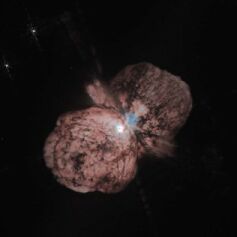Eta Carinae
 Click here to see a much bigger version of the above image, or find many more Chandra images of Eta Carinae |
Read about the possibilities of Eta Carinae going hypernova…
What We Know…
According to the Universal Book of Astronomy, Eta Carinae is:
One of the most massive and remarkable known stars; it lies in the constellation Carina. Surrounded by the largest diffuse nebula in the sky, the Eta Carinae Nebula, it is an S Doradus star with a mass of over 100 Msun and a luminosity of about 4 million Lsun, putting it close to the theoretical limit of stellar stability. Only by shedding matter at the prodigious rate of 0.1 Msun per year has it managed to stay in one piece so far. Its variability is extraordinary.
In 1843, it reached a visual magnitude of -1, making it, briefly, the second brightest star after Sirius, despite its distance of some 7,500 light-years. Accompanying this visual brightening was an expulsion of 2 to 3 Msun of material from the star’s polar regions. This material, spewed from the star at speeds close to 700 km/s, formed two large, grayish, bipolar lobes, nicknamed the Homonculus Nebula, that have been photographed in spectacular detail by the Hubble Space Telescope. Each lobe currently expands at a rate of 2.4 million km/hr and spans about 6.4 trillion km.
After the great eruption of the mid-nineteenth century, Eta Car faded in spurts to below naked-eye visibility, settling at about seventh magnitude. Recently, it has started to brighten again, gaining a full magnitude from 1950 to 1992 and is continuing its ascent. Eta Car emits powerfully across a range of wavelengths. At some infrared wavelengths, the star and its nebula are the brightest objects in the sky beyond the Solar System. The mid-infrared emission originates in dust ejected by the star during giant mass-loss events within the past several hundred years. X-rays come from an outer, horseshoe-shaped ring with an electron temperature of about 3 million K, that is about 2 light-years in diameter and was probably caused by an outburst that happened more than a thousand years ago. Regular, small-scale variations in the star’s ultraviolet and X-ray output, with a period of 5.5 years, have led to the suggestion that Eta Car is actually a binary star. According to this theory, previous eruptions may have been due to the orbital interactions of the two stars. As for the star’s powerful X-ray emission, most astronomers agree that this is the result of the collision of two dense stellar winds, but whether these emanate from the two stars of a close interacting binary system or from the fast and slow stellar winds of a single star remains unclear. One thing seems certain: Eta Carina is doomed to explode as a supernova in the not-too-distant future.[1]
[emphasis added]
[1] The Universal Book of Astronomy, David Darling, Published by John Wiley & Sons, New York, October 2003

